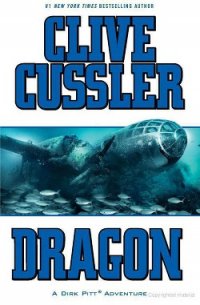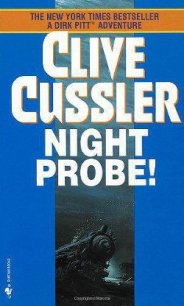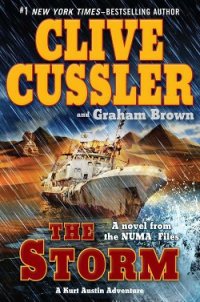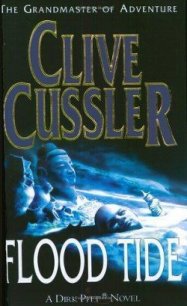Black Wind - Cussler Clive (читать книги онлайн без сокращений TXT) 📗
McCasland peered over the gunwale with a pair of night vision binoculars trained on the sentry post at the mouth of the channel. Two men looked back from the interior of their guard hut but made no move toward a black speedboat tied up a few feet away. Satisfied the guards were too lazy to investigate further, he called quietly to the three men beside him.
“In the water. Now.”
With the gracefulness of a Persian cat leaping from a settee, the three men slipped quietly over the side and into the water with barely a gurgle. McCasland adjusted his faceplate, gave a thumbs-up to the two “fishermen,” then followed the frogmen over the side. Having grown hot in the boat wearing the insulated wet suit, he was refreshed by the cool water as it seeped against his skin. Clearing his ears, he submerged to a depth of twenty feet, then leveled off, peering around into the black gloomy murk. The dank polluted harbor water offered only a few feet of visibility, which fell to zero at night without a flashlight. McCasland ignored the blind diving conditions and spoke into a wireless underwater communication system attached to his face mask.
“Audio and nav check,” he barked.
“Bravo here. Nav confirmed. Out,” came one voice.
“Charlie here. Nav confirmed. Out,” followed a second voice, this one with a slight Georgia twang.
“Delta here. Nav confirmed. Out,” the third diver's voice copied.
“Roger, stand by,” McCasland replied.
Above them, the two SEALs in the sampan had beached the boat next to a battered and abandoned pier within sight of Kang's security men. Making a show of repairing the boat, the two men clanged tools together and cursed loudly as they pretended to fumble with the motor while the men in the water carried out their mission.
Below the surface, McCasland activated his Miniature Underwater GPS Receiver (MUGR), or “Mugger” as it was nicknamed. No larger than a Palm Pilot, the small device contained a navigation system that was calibrated by signals from the GPS satellite system. McCasland briefly kicked up to a depth of ten feet, where the underwater receiver could pick up the GPS signal and establish a fixed base point. A muted green display screen popped on, displaying an animated trail that zigzagged through and around a series of obstacles. Based on aerial survey photographs and the description provided by Dirk and Summer, McCasland had programmed a series of GPS way points into the Mugger. The aggregate points created a path to the covered dock entrance they could follow while completely submerged. All four divers held one of the devices, which also showed one another's relative position with a tiny flashing light. Swimming in complete darkness, they could follow the path to the covered dock while staying within just a few feet of one another.
“Okay, let's move,” he spoke into his faceplate after descending again.
With a deep thrust of his fins, McCasland kicked forward into the inky water, his eyes glued to the electronic compass and depth gauge, which he ensured never wavered from the twenty-foot mark. Reaching the entrance to the private ship channel, he turned and swam into the narrow inlet, passing almost directly beneath the security guards' speedboat, which bobbed on the surface well above him. Over McCasland's shoulder, the three other SEALs followed in a triangular pattern a few feet behind.
Day or night, the SEAL divers would have been nearly impossible to detect due to their use of rebreathers. Forgoing the standard dive tank of compressed air, which generates telltale exhaust bubbles visible on the surface, the Navy divers utilized a Carleton Technologies VIPER system for their air supply. Embedded within a sleek-looking backpack, the VIPER rebreather provided pure oxygen to the divers that was recirculated through a chemical scrubber, which removed harmful carbon dioxide while dispelling only a minute amount of exhaust. The streamlined system could enable the divers to remain underwater for up to four hours should the need arise. But with no visible exhaust bubbles rising to the surface, their whereabouts were safely concealed from the naked eye.
Following the Mugger's imaginary trail, the four divers swam through the winding inlet, kicking through the black water until they approached the entrance to the enclosed dock. The quarter-mile submerged swim would have exhausted most sport divers, but years of demanding physical training made it seem like crossing the street to the hardened SEALs. Their heartbeats thumped just above resting as they regrouped in front of the massive door to the enclosed dock. McCasland then swam in a circular pattern until his hands found a pylon that supported one side of the entrance. Following the pylon up, he ascended slowly until finding the lower edge of the sliding door, which hung three feet beneath the water's surface. Confident he was at the proper location, he descended again to the depth of the other divers.
“Proceed with preliminary recon. Regroup this position in three-zero. Out.”
From this point on, each diver had a different trail to follow inside the covered dockyard. Dirk and Summer had drawn a detailed map of the dock layout from memory, which was used to establish a different reconnaissance point for each diver. McCasland had the farthest and most dangerous assignment, to swim to the land's-end side of the dockyard for a frontal view of the facility. Two other divers would reconnoiter the main dock to verify and film the Baekje, while the fourth diver would stand by as backup near the entrance door.
The bright overhead lights of the hangar illuminated the upper water shallows, casting a dark shadow from the dock's supporting concrete pilings. McCasland found that at a depth of fifteen feet, he could just make out the dark outline of the pilings in the water ahead of him. He held the Mugger to his chest and kicked harder, using his vision to guide him quickly down the length of the dock. After passing dozens of pilings, a solid wall of concrete suddenly rose up before him and he knew that he had reached the end of the pier. Resting against a pylon, he readied a digital camcorder and prepared to surface, fighting back an uneasy feeling of defeat. He had felt a strange void while swimming beneath the pier, sensing an absence of the mass he thought he should feel nearby even though it was out of sight.
Quietly breaking the water's surface beneath the edge of the dock, his eyes confirmed the empty feeling in his stomach. The giant covered dockyard was bare. There was no four-hundred-foot cable ship tied up in front of him. In fact, the main dock was completely empty. McCasland silently scanned the facility with his camera, finding only one vessel in the entire structure, a beat-up tugboat perched on a dry-dock. Nearby, a group of bored dockworkers on the graveyard shift were chasing each other around in a forklift, the only signs of life in the massive structure.
His filming complete, McCasland ducked underwater and kicked back along the dock toward the main entrance door. Reaching the support pylon, he pulled up the Mugger and saw that the other three divers had already returned and were waiting in the surrounding waters a few feet away.
“Mission complete,” he said curtly, then swam off into the inlet.
The four SEALs made their way back to the beached sampan and silently crawled inside. The mock fishermen suddenly found the cure to the ailing motor and restarted the outboard engine. With more vocal cursing, they cruised past Kang's inlet and motored off into the night.
Once out of sight, McCasland sat up and took off his faceplate, taking a breath full of the dank port air while staring at the twinkling waterfront lights. A drop of rain struck him on the face, then another and another. Shaking his head, he sat silently while a healthy deluge opened up from the skies on the frustrated commando.




